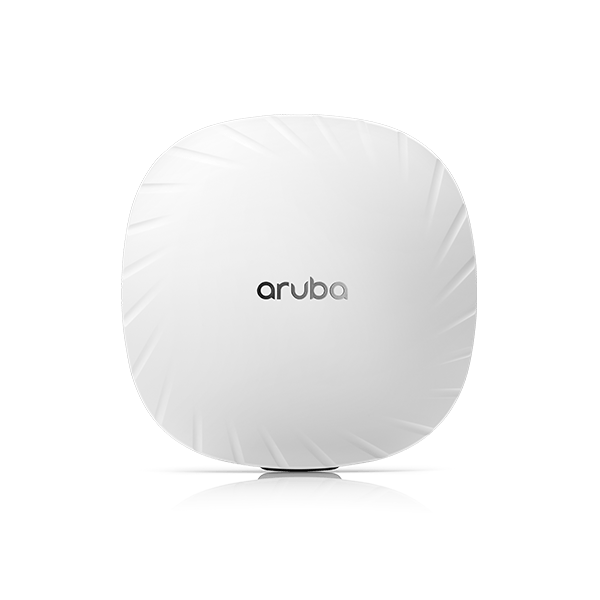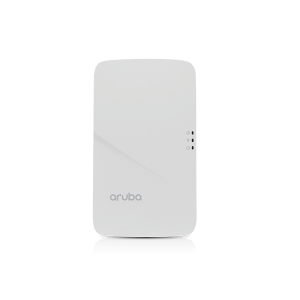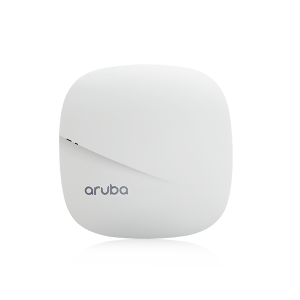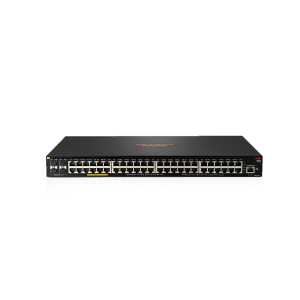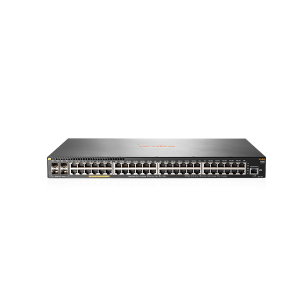Description
Overview
Aruba’s Wi-Fi 6 AP supports Zigbee, Bluetooth 5, and third-party overlays, making it easier to deploy and manage IoT services and providing telemetry for Aruba Central’s contact-tracing dashboards. Stronger encryption and authentication, secure credentials/keys storage, and user and IoT access policy enforcement firewalls protect network security.
Specifications
Hardware Variants
AP-534: External antenna models
AP-535: Internal antenna models
Wi-Fi Radio Specifications
AP type: Indoor, dual radio, 5GHz and 2.4GHz 802.11ax 4×4 MIMO
5GHz radio: Four spatial stream Single User (SU) MIMO for up to 2.4Gbps wireless data rate with individual 4SS HE80 (or 2SS HE160) 802.11ax client devices, or with four 1SS or two 2SS HE80 802.11ax MU-MIMO capable client devices simultaneously
2.4GHz radio: Four spatial stream Single User (SU) MIMO for up to 1,150Mbps wireless data rate with individual 4SS HE40 802.11ax client devices or with two 2SS HE40
802.11ax MU-MIMO capable client devices simultaneously
Support for up to 1,024 associated client devices per radio, and up to 16 BSSIDs per radio
Supported frequency bands (country-specific restrictions apply):
- 2.400 to 2.4835GHz
- 5.150 to 5.250GHz
- 5.470 to 5.725GHz
- 5.725 to 5.850GHz
- Available channels: Dependent on configured regulatory domain
Dynamic frequency selection (DFS) optimizes the use of available RF spectrum
Supported radio technologies:
- 802.11b: Direct-sequence spread-spectrum (DSSS)
- 802.11a/g/n/ac: Orthogonal frequency-division multiplexing (OFDM)
- 802.11ax: Orthogonal frequency-division multiple access (OFDMA) with up to 37 resource units (for an 80MHz channel)
Supported modulation types:
- 802.11b: BPSK, QPSK, CCK
- 802.11a/g/n: BPSK, QPSK, 16-QAM, 64-QAM, 256-QAM (proprietary extension)
- 802.11ac: BPSK, QPSK, 16-QAM, 64-QAM, 256-QAM, 1024-QAM (proprietary extension)
- 802.11ax: BPSK, QPSK, 16-QAM, 64-QAM, 256-QAM, 1024-QAM
802.11n high-throughput (HT) support: HT20/40
802.11ac very high throughput (VHT) support: VHT20/40/80/160
802.11ax high efficiency (HE) support: HE20/40/80/160
Supported data rates (Mbps):
- 802.11b: 1, 2, 5.5, 11
- 802.11a/g: 6, 9, 12, 18, 24, 36, 48, 54
- 802.11n: 6.5 to 600 (MCS0 to MCS31, HT20 to HT40), 800 with 256-QAM
- 802.11ac: 6.5 to 1,733 (MCS0 to MCS9, NSS = 1 to 4, VHT20 to VHT160), 2,166 with 1024-QAM
- 802.11ax (2.4GHz): 3.6 to 1,147 (MCS0 to MCS11, NSS = 1 to 4, HE20 to HE40)
- 802.11ax (5GHz): 3.6 to 2,402 (MCS0 to MCS11, NSS = 1 to 4, HE20 to HE160)
802.11n/ac packet aggregation: A-MPDU, A-MSDU
Transmit power: Configurable in increments of 0.5 dBm
Maximum (aggregate, conducted total) transmit power (limited by local regulatory requirements):
- 2.4 GHz band: +24 dBm (18dBm per chain)
- 5 GHz band: +24 dBm (18 dBm per chain)
Note: conducted transmit power levels exclude antenna gain. For total (EIRP) transmit power, add antenna gain.
Advanced Cellular Coexistence (ACC) minimizes the impact of interference from cellular networks
Maximum ratio combining (MRC) for improved receiver performance
Cyclic delay/shift diversity (CDD/CSD) for improved downlink RF performance
Space-time block coding (STBC) for increased range and improved reception
Low-density parity check (LDPC) for high-efficiency error correction and increased throughput
Transmit beam-forming (TxBF) for increased signal reliability and range
802.11ax Target Wait Time (TWT) to support low-power client devices
Wi-Fi Antennas
AP-534: Four (female) RP-SMA connectors for external dual band antennas (A0 through A3, corresponding with radio chains 0 through 3). Worst-case internal loss between radio interface and external antenna connectors (due to diplexing circuitry): 0.8dB in 2.4GHz and 1.3dB in 5GHz.
AP-535: Four integrated dual-band downtilt omni- directional antennas for 4×4 MIMO with peak antenna gain of 3.5dBi in 2.4GHz and 5.4dBi in 5GHz. Built-in antennas are optimized for horizontal ceiling mounted orientation of the AP. The downtilt angle for maximum gain is roughly 30 degrees.
- A mix of horizontally and vertically polarized antenna elements is used
- Combining the patterns of each of the antennas of the MIMO radios, the peak gain of the combined, average pattern is 1.9dBi in 2.4GHz and 3.5dBi in 5GHz.
Other Interfaces
E0, E1: HPE SmartRate port (RJ-45, maximum negotiated speed 5Gbps)
- Auto-sensing link speed (100/1000/2500/5000BASE-T) and MDI/MDX
- 2.5Gbps and 5Gbps speeds comply with NBase-T and 802.3bz specifications
- POE-PD: 48Vdc (nominal) 802.3af/at/bt POE (class 3 or higher)
- 802.3az Energy Efficient Ethernet (EEE)
Link aggregation (LACP) support between both network ports for redundancy and increased capacity
POE power can be drawn from either port (single source, or set to prioritize) or both ports simultaneously (set to combine) When set to prioritize, the AP draws power from E0 and may failover to E1.
DC power interface: 48Vdc (nominal, +/- 5%), accepts 1.35mm/3.5mm center-positive circular plug with 9.5mm length
USB 2.0 host interface (Type A connector)
- Capable of sourcing up to 1A / 5W to an attached device
Bluetooth 5.0 Low Energy (BLE5.0) and Zigbee (802.15.4)* radio - BLE: up to 8dBm transmit power (class 1) and -95dBm receive sensitivity
- Zigbee: up to 8dBm transmit power and 99dBm receive sensitivity
- Integrated vertically polarized omnidirectional antenna with roughly 30 degrees downtilt and peak gain of 3.1dBi (AP-535) or 5.0dBi (AP-534)
Visual indictors (two multi-color LEDs): for System and Radio status
Reset button: factory reset, LED mode control (normal/off)
Serial console interface (proprietary, micro-B USB physical jack)
Kensington security slot

